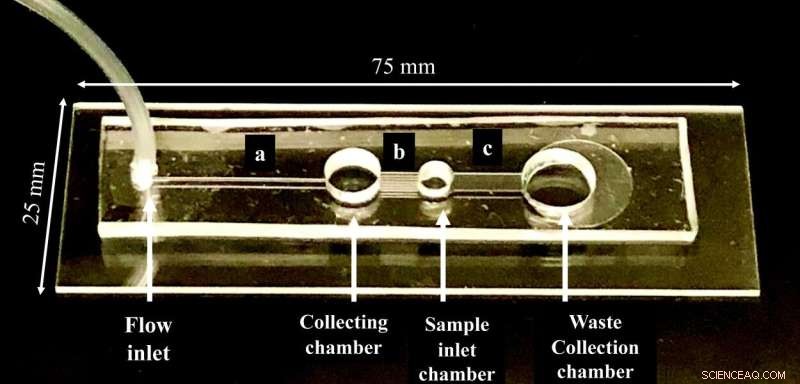
Il chip microfluidico è costituito da quattro camere cilindriche collegate tramite microcanali:la camera di ingresso del fluido, la camera di raccolta, la camera di ingresso del campione e la camera di raccolta dei rifiuti. Credito:Florida Atlantic University
Il tratto genitale femminile può essere un ambiente ostile per il concepimento. Su circa 100 milioni di spermatozoi, solo poche centinaia arrivano alle tube di Falloppio. Guidati da un movimento direzionale chiamato reotassi, gli spermatozoi nuotano contro il flusso del muco cervicale per raggiungere l'uovo per la fecondazione. Questo viaggio, tuttavia, è ancora più critico quando si considera l'infertilità. La motilità degli spermatozoi, la capacità di nuotare nel modo giusto, è fondamentale.
Sfruttando questo comportamento di reotassi naturale dello sperma, i ricercatori del College of Engineering and Computer Science della Florida Atlantic University hanno sviluppato un chip microfluidico per lo smistamento degli spermatozoi che è veloce, economico, facile da usare e isola in modo efficiente lo sperma sano direttamente dallo sperma. È importante sottolineare che raccoglie senza sforzo gli spermatozoi selezionati dalla camera di raccolta riducendo al minimo la contaminazione da parte di spermatozoi deformati o morti.
Le tecnologie di riproduzione assistita come la fecondazione in vitro (IVF), l'inseminazione intrauterina e l'iniezione intracitoplasmatica di spermatozoi richiedono tutte spermatozoi sani per un esito positivo. Gli attuali metodi di centrifugazione per lo smistamento degli spermatozoi richiedono più passaggi, più tipi di apparecchiature e impiegano circa due ore per isolare gli spermatozoi. Questi metodi danneggiano lo sperma durante l'elaborazione e inducono una significativa frammentazione del DNA e stress ossidativo.
Risultati dello studio, pubblicati sulla rivista The Analyst della Royal Society of Chemistry, ha mostrato che gli spermatozoi isolati dalla camera di raccolta in questo chip microfluidico mostravano una motilità significativamente maggiore (quasi il 100 percento), un numero maggiore di cellule morfologicamente normali e una frammentazione del DNA sostanzialmente inferiore, che è un parametro cruciale per il processo di fecondazione. Inoltre, il chip sviluppato fornisce cellule più che sufficienti necessarie per un'iniezione intracitoplasmatica di spermatozoi di successo a causa della quantità e della qualità degli spermatozoi isolati utilizzando il chip.
"Il funzionamento del nostro chip è molto semplice. Una volta che lo sperma è stato caricato nella camera di ingresso del campione, gli spermatozoi competenti iniziano a muoversi contro il flusso del fluido verso la camera di raccolta da dove possono essere facilmente raccolti", ha affermato Waseem Asghar, Ph.D. , autore senior, professore associato presso il Dipartimento di ingegneria elettrica e informatica della FAU e membro del FAU Institute for Human Health and Disease Intervention (I-Health) e FAU Institute for Sensing and Embedded Network Systems Engineering (I-SENSE) . "Inoltre, questo chip offre un vantaggio operativo di un'ora in un passaggio, che un operatore può utilizzare con una formazione minima."
The study also validates that rheotaxis selects the healthy, motile, and higher velocity sperm cells for the fertilization process.
"The assembly of the microfluidic chip is low-cost, and the reagents used in the chip to separate sperm cells are only a few milliliters, therefore, the commercial cost of the chip would be less than $5," said Asghar. "Moreover, this technology will considerably reduce the economic burden of fertility implementations and both the chip and the sperm cells isolated from it offer great clinical significance and applicability."
The microfluidic chip consists of four cylindrical chambers that are connected through the microchannels. The four chambers are the fluid inlet chamber, collecting chamber, sample inlet chamber, and waste collection chamber. The channel between the collecting chamber and sample inlet contains microgrooves to guide the sperm cells in addition to the fluid flow for the rheotaxis movement of the sperm cells towards the collecting chamber.
The shear stress inside the device is generated by fluid flow using a syringe pump. A raw semen sample is then added to the sample inlet chamber from where functional sperm cells will swim towards the collecting chamber, effectively separating themselves from dead and immotile sperm.
"Conventional centrifugation often compromises the integrity of sperm cells. This research study demonstrates that the microfluidic chip developed by professor Asghar and his colleagues eliminates this issue," said Stella Batalama, Ph.D., dean, College of Engineering and Computer Science. "This novel technology offers a platform where the sperm cells experience different shear stress in different parts of the chip, which facilitates the isolation of competent sperm cells without impacting their integrity."
In the United States, an estimated 15 percent of couples have trouble conceiving. Globally, approximately 48.5 million couples experience infertility. According to the U.S. Centers for Disease Control and Prevention, 12 percent of women of childbearing age have used an infertility service. All treatment costs for infertility can range from $5,000 to $73,000. The average patient goes through two IVF cycles, bringing the total cost of this procedure, including medications, between $40,000 and $60,000. An estimated 85 percent of IVF costs are often paid out-of- pocket. + Esplora ulteriormente